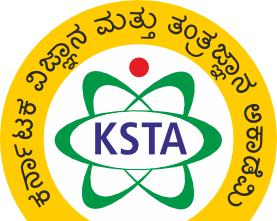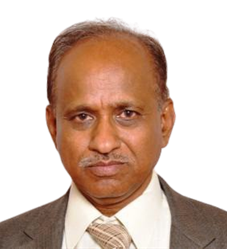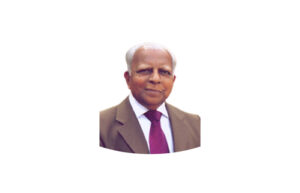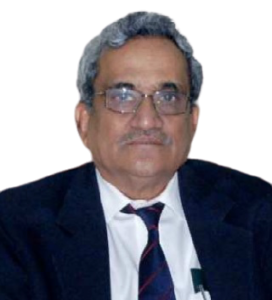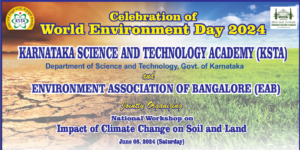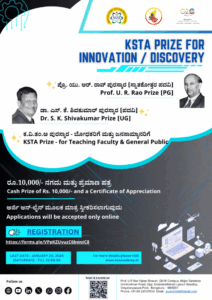Nurturing Excellence in Science Education and Research – Prof. B. G. Mulimani and Prof. J. R. Tonannavar
19 min readFrontiers of knowledge, in every branch of science, are on the move at an unprecedented rapid pace. Science is the base for the development of every nation. Let us not forget that it is our mathematicians – Brahamagupta, Bhaskara and other’s fundamental contributions to mathematics including the ‘Number – ZERO’, have been the greatest inventions of man. Notwithstanding rich intellectual tradition, today we are in a dilemma as to how to promote ‘excellence’ in science education and research. This dilemma has been apparent in the recent proliferation of publications in predatory research journals. The UGC ought to set a baseline of standard for research in India. While India is going through the era of liberalization, privatization and globalization, there is an urgent need for nurturing excellence in science teaching and research. Attaining excellence in science education is a must for producing such human resource as required, among others, for the successful implementation of Science and Technology Policy initiatives by the Government to realize the vision of a developed India. Higher education in India is a complex landscape rooted in the socio-cultural setting and the present article is an anthology of motivations and sayings of the eminent scientists including our perspectives and broad suggestions.
For long, the human life and society have been dominated by the forces associated with religion and authority. It is very recently, the emergence of new way of thinking-scientific method, has changed the way we think and live. Science has become an integral part of our living. Science being knowledge of a certain kind arrived on the horizon in the 17th century in full scale, bringing with it an attitude of cool rational outlook. Today the impact of science on the lay-person has more to do with its technological spin-offs rather than stimulating one to cultivate scientific temper. Scientific method as we know it today comes down to us from Galileo, who established ‘Observation of significant facts, framing of hypothesis, which if true, explains the facts and predictions as consequences from it are verified’ as the basis. Best example for the scientific method comes from Newton who cast his laws of motion in mathematical forms, making them logical, verifiable and predictable. On the other hand, the biologist Charles Darwin provided a huge mass of evidence in favor of a mechanism that explains the theory of origin and evolution of species. He propounded that ‘From so simple a beginning endless forms, most beautiful and most wonderful forms have been, and are being evolved’. Since Darwin, the theory of evolution has passed several tests, proving its scientific merit. In the words of geneticist Theodosius Dobzhansky, ‘Nothing in biology makes sense except in the light of evolution’. Matt Ridley in his recent book ‘The Evolution of Everything’ opines that we can now gradually understand or explain evolution of everything: be it education, culture, morals, religion, money or internet. Another new dimension added to the scientific method is by Albert Einstein who demonstrated the power of thought experiments, that is, situations are imagined in a new way but bound by the laws of physics. In his own words, ‘I was sitting in a chair in the patent office at Bern when all of a sudden a thought occurred to me: If a person falls freely he will not feel his own weight. I was startled. This simple thought made a deep impression on me. It impelled me toward a theory of gravitation’. Today the scientific method has essentially remained the same since the 17th century though in some cases its application and practice are more complex. Physics is more exact science because its laws obey the principles of mathematics. This is also true of Chemistry whose base is now molecular and its practice is as much science as it is an art. Being a fundamental science, chemistry is, in a way, at the heart of every branch of science. Different branches of social sciences are increasingly becoming scientific on account of the application of scientific method.
Scientific temper is an attitude of mind to be adopted from the scientific method as a mental habit. It is supposed to free the mind from blind beliefs and dogmas. Scientific outlook refers to the role of scientific method in so far as it can influence religion, ethics, society, psychology, education, public policy and governance. There is no denying the fact that a nation’s intellectual and economic prowess are measured by its scientific progress. While art in the life of the world civilizations is very ancient, science, by contrast, is recent but the impact of science on the modern civilization has been deep and wide and will continue to be so. The explosion of scientific knowledge and technological advancement as its spin-offs have had influence on social, cultural, intellectual and economic life of the modern man. Industrial revolution demonstrated what Francis Bacon had said, ‘Knowledge is Power’. Modern science began with Copernicus, Kepler, Galileo and Newton as an act of understanding the motions of heavenly bodies by asking right kind of questions by them with a penetrating intellect that challenged the authority and Aristotelian world-view, thereby unraveling nature’s secrets. Bertrand Russell says of these men, ‘Unprejudiced observation without regard to aesthetic prejudices required therefore, at that time, a rare intensity of scientific ardor’. These men of science did not concern themselves about the immediate practical applications of their discoveries; instead, they sought to deduce an impersonal world-view of the underlying fundamental laws of motion of the celestial bodies, subject to verification and interpretation. With further scientific progress, it was soon realized in the 18th and 19th centuries that the values of science are: to enjoy studying nature, to gain certain knowledge and to put it to utility. These values constitute what may be called ‘scientific outlook’ which deserves to be treated as a culture on par with those imparted by liberal education. According to the American Association for the Advancement of Science, ‘ideally, a liberal education produces persons who are open-minded and free from provincialism, dogma, preconception, and ideology; conscious of their opinions and judgments; reflective of their actions; and aware of their place in the social and natural worlds’. It was believed until the 19th century that teaching of literature, ethics, philosophy, and so on, refined the human mind to the highest form of culture. The teaching of science in the context of liberal education clearly did not find its rightful place due mainly to misplaced notion that it deals with utilitarian aspects such as motors, airplanes, telegraphy and medicines and therefore, these aspects cannot refine the human mind in a manner that art and literature do. However, the educational value of science is the mental excellence which is as great as that of literature. From a utilitarian view-point, the teaching of science prepares men and women to be a desired skilled human resource for practical and economic goals. The teaching of Science, Technology, Engineering, Art and Mathematics, popularly shortened to STEAM, is emphasized in the contemporary higher education, since, the importance of these subjects in school and college pedagogy is directly associated with training human resource for the successful implementation of science and technology policies.
Science, as noted, is a certain kind of knowledge derived by observation of significant facts and from the facts we arrive at general laws. Therefore, the scientific method in essence involves, firstly, observation of facts; secondly, framing a hypothesis to account for these facts; thirdly, if the hypothesis is true, deductions from the hypothesis are verified experimentally. By the method of induction, a certain general law follows from the facts. Using the general law, we proceed in reverse order deductively until we arrive at the particular facts with which we started inductively. The scientist discovers a law by the method of induction and the teacher in the class room uses deduction to demonstrate the truth of the law. The scientist has a child-like curiosity and it is his business to ask right kind of questions. What is it? Why is it? How is it? Finding answers to questions leads him to solutions. It is said of Einstein that as a young boy he asked ‘What would I see if I moved with the speed of light?’ In his quest for the answer, he discovered ‘Theory of Relativity’. Eminent physical chemist E. Bright Wilson Jr. says, ‘Many scientists owe their greatness not to their skill in solving problems but to their wisdom in choosing them’. In this context, the story of Bharat Ratna Prof. C.N.R. Rao, is exemplary. In his autobiography, ‘Life in Science’, he recalls, ‘When I started my career, I tried to pick an area of research where I could contribute significantly. I looked for an area which was not crowded and was guided by Robert Frost’s famous poem:
Two roads diverged in a yellow wood
And sorry I could not travel both
I took the one less travelled by
And that made all the difference
Picking a lonely road is a still a good way to choose a research area, but this is becoming increasingly different nowadays’. The cultivation of science by scientists is many-sided. Let us look at what different scientists have to say what science is for, how it is pursued and what it means to them. Eminent scientist Dr. Raghunath Mashelkar, Former DG, CSIR says, ‘The first grand challenge before Indian science is that of building some irreverence. Our students are too reverent’. We must encourage students to question authority which has no place in science. On this the IISc’s scientist, Prof. Gautam Desiraju concurs:’ The Indian is too scared to question authority of any form. He would rather swim along with the current. He does not dare to differ. All this runs counter to the scientific disposition, which proceeds systematically along the route of questioning, formulation, experimentation and verification’. Polish-born, British scientist and author Jacob Bronowski says that the essence of science is to ‘ask an impertinent question and you are on the way to a pertinent answer’. Japanese-born-American Nobel Laureate Leo Esaki was inspired by the following words at the bust of Alexander Graham Bell which stands at the main entrance to the Bell Labs: Leave the beaten track occasionally and dive into the woods. You’ll be certain to find something that you’ve never seen before. Inspired by these words, Esaki joined IBM T. J. Watson Research Center, New York, where he invented a diode that demonstrated electron tunneling, a novel quantum mechanical result thought to be realizable only in special conditions. So choosing an unbeaten path makes all the difference. On another level, what science seeks to achieve? English philosopher Herbert Spencer stated: ‘science is organized knowledge’. American microbiologist Cornelius van Neil defines: ‘In essence, science is a perpetual search for an intelligent and integrated comprehension of the world we live in’. Austrian zoologist Konrad Lorenz thinks of search for truth as – ‘Truth in science can best be defined as the working hypothesis best suited to open the way to the next better one’.
In the making of a scientist, motivations play a decisive role. It would be inspiring to consider the early life of Prof. C.N.R. Rao. Born and educated in Bangalore, he not only had the benefit of his learned parents but also was taught by very motivating physics and chemistry teachers at school. After his graduation at a very young age of 17 from the Central College, Bangalore, one of his teachers advised him to enroll for a postgraduate degree in Physics and Chemistry at Banaras Hindu University instead of his desire to join the Indian Institute of Science (IISc.). After M.Sc, he had a brief stint at IISc, and then he joined the faculty at Indian Institute of Technology (IIT), Kharagpur. He was impressed by Nobel Laureate Linus Pauling’s famous book, The Nature of Chemical Bond. The book’s approach to chemistry through the structure of atoms and molecules appealed to him. His desire to work in modern chemistry as instigated by Pauling, combined with the IIT’s Director Sir J. C. Ghosh’s suggestion to pursue it outside the country took him to the U.S (1954). After securing admission to both Massachusetts Institute of Technology (MIT) and Purdue Universities, he chose the latter because it gave him a chance to work with a professor who had been from Linus Pauling’s research group. After his post-doctoral stint at the University of California at Berkley, he joined the IISc, Bangalore. His life has been defined by three coordinates: (1) Science as a way of life; (2) Faith as source of energy and (3) Institutions as magnets for harnessing new knowledge. Nobel Laureate Ahmed Zewail aptly describes Prof Rao’s scientific life: ‘A voyage of success and a man who believes in excellence but disbelieves in mediocrity and bureaucracy’ .
One is fortunate enough to be raised by educated parents as is true of Niels Bohr, Homi Bhabha and Sir C.V. Raman who found themselves in favorable circumstances like good school and college, parent’s academic habits and accidental meetings with eminent persons while they were children. Bohr’s father was an academician and his brother became a distinguished mathematician. Bhabha was the son of a wealthy lawyer, who, with a wonderful collection of books, encouraged young Bhabha who became a voracious reader. Highly talented Bhabha studied the theory of relativity at the age of sixteen. While his parents wished him to be become an engineer to run an industry, he was repulsive of the idea and said this to his father, ‘I’m burning with a desire to do Physics. I will and must do it some time. It is my only ambition’. With this burning desire, Bhabha went on to become not only an exceedingly successful nuclear scientist but also built two institutions, one for pursuing peaceful uses of nuclear energy, now called Bhabha Atomic Energy Research Center (BARC) and another for pursuing fundamental research, called Tata Institute of Fundamental Research (TIFR). Of the many books Raman read as a student, the three books that greatly influenced his spiritual and intellectual outlook include: Edwin Arnold’s The Light of Asia on the Lord Buddha, The Elements of Euclid and the great German scientist Hermann von Helmholtz’s classic The Sensations of Tone. Of the first book Raman says, ‘I remember being powerfully moved by the story of Siddhartha’s great renunciation, of his search for truth and of his final enlightenment. This was at a time when I was young enough to be impressionable, and this reading of the book fixed firmly in my mind the idea that this capacity for renunciation in the pursuit of exalted aims is the very essence of greatness’. Of the second book, the young Raman’s evaluation of it is indeed remarkable, ‘. . .my early reactions to the compulsory study of Euclid were anything but favorable. The reason for this is, I think, to be found in the excessive emphasis placed on the subject as an intellectual discipline and the undue attention given to details as distinguished from its broader aspects. He finally concludes, ‘The pages of Euclid are like the opening bars of the music of the grand opera of Nature’s great drama. So to say, they lift the veil and show to our vision a glimpse of a vast world of natural knowledge awaiting study’. About the last book, this is what Raman has to say, ‘I discovered this book for myself and read it with the keenest interest and attention. It can be said without exaggeration that it profoundly influenced my intellectual outlook. For the first time, I understood from its perusal what scientific research really meant and how it could be undertaken. I also gathered from it a variety of problems for research which were later to occupy my attention and keep me busy for many years’. Clearly, Helmholtz’s master piece, like an inspiring teacher, profoundly influenced the young Raman, to say the least, to become a scientist. Nuclear physicist Dr. Raja Ramanna too had similar upbringing due to his father, a learned judge and a mother with a taste in English literature. If the upbringing and books to which some scientists partly owe their success, teachers, accidental incidents, meeting and hearing eminent scientists too have their share of influence. One of the India’s great scientists of the 20th century, Sir Jagdish Chandra Bose had come under the influence of his physics teacher, Father Lafont at St. Xavier College, Kolkata, who molded him to be a scientist. Likewise, many scientists as teachers at the University of Cambridge influenced the young Bose. It was Sir C.V. Raman’s inspiring lecture at the school and an opportunity to visit his lab at the Indian Institute of Science made Prof. C.N.R. Rao to say ‘My god, how wonderful it would be to be like C.V. Raman. It was probably then the seeds of my becoming a scientist was sown’. Born in a wealthy family and his father being a practicing lawyer, James Clerk Maxwell, was tutored and educated at the University of Cambridge. His electromagnetic theory is one of the greatest discoveries in science. There are exceptions to these stereotypes of making a scientist. Albert Einstein, though was born in a middle-class family, received modest education at a gymnasium in Switzerland (his mother taught him to play violin). In the case of Charles Darwin whose father was a doctor, he was encouraged to follow in the footsteps of his father but chose to be a naturalist. Despite just a pass degree from the University of Cambridge, Darwin went on to become a greatest biologist thanks to his revolutionary theory on the human evolution. Isaac Newton came from a farming family with no early advantages but rose to become the greatest scientist ever on account of his fundamental discoveries in mechanics and optics. He ushered in a Newtonian era. Mathematical genius Srinivas Ramanujan whose parents were by any measure not learned but he turned out to be once-in-a-millennium mathematician with such discoveries that have kept mathematicians busy even today.
The history of science since Galileo, Newton, Darwin, Einstein and others has amply demonstrated that, the pursuit of science is also equally important for the culture of man and his society. In the words of the great mathematician Henry Poincare’ ‘The scientist does not study nature because it is useful to do so. He studies it because he takes pleasure in it; and he takes pleasure in it because it is beautiful. If nature were not beautiful, it would not be worth knowing and life would not be worth living’. While science has impacted our world-view, its bond with religion is delicate and often seen as confrontational. At the core of religion lies faith. In science too beliefs are held by scientists. Science is bound by verifiable evidence which is transcendental in religion. It is pertinent to consider what Einstein has said: ‘A religious person is devout in the sense that he has no doubt of the significance of those super personal objects and goals which neither require nor capable of rational foundation. A legitimate conflict between science and religion cannot exist. Science without religion is lame, religion without science is blind’. There is probably a need to blend scientific outlook with ancient wisdom and modern science, the teaching of which would produce a strong India. In this context it may be noted the Indian Constitution was amended (42nd Amendment Act, 1976) incorporating Article 51A making provision for, among the Fundamental Duties for citizens of India, ‘(h) to develop the scientific temper, humanism and the spirit of inquiry and reform’.
It is said that ‘India is a rich country where poor people live, because we have not understood the wealth creating potential of knowledge’. We have become consumers of knowledge, not creators of knowledge. How do we address the need for a paradigm shift in our higher education system? There is a need to grow the culture of creativity embedded in Indian culture and ethos without the feeling of being inferior to the West. Raman has expressed this lack of confidence with admirable lucidity: We have abundant human material in India. Speaking as a teacher of 24 years experience, I can assert, without fear of contradiction that the quality of the Indian mind is equal to the quality of any Teutonic, Nordic, or Anglo-Saxon mind. What we lack is perhaps courage, what we lack is perhaps driving force which takes one anywhere. We have, I think developed an inferiority complex. I think what is needed in India today is the destruction of that defeatist spirit. We need a spirit of victory, a spirit that will carry us on to our rightful place on this planet. If that indomitable spirit were to arise, nothing can hold us from achieving our rightful destiny.
It is educative to note that the great Astrophysicist Subramanyam Chandrashekar attributed the phenomenon of sudden emergence of greats like J.C. Bose, C.V. Raman, M.N. Saha, S.N. Bose, P.C. Rayand others during the period from 1920 to 1925 with the motive for self-expression –to show to the West that Indians were equal to them in their own realm. It must be acknowledged that since Raman, India has had men of eminence -Vikram Sarbhai, Verghese Kurien, Satish Dhawan, Dr. A.P.J. Abdul Kalam, Dr. M.S. Swaminathan, Dr. Yash Pal and Dr. Raghunath Mashelkar to name a few whose impeccable zeal, vision and commitment have transformed India into a nation of many achievements. The legacy of space science and communication are due to the pioneers: Vikram Sarbhai and Satish Dhawan. Verghese Kurien unleashed the largest dairy program as ‘White Revolution’ and creating ‘Amul’ brand that has successfully countered international brands. Dr. Abdul Kalam provided leadership for the missile development program. India owes ‘Green Revolution’ to Dr. Swaminathan. Dr. Mashelkarhas been the architect of the legislative framework of patents and intellectual property rights, replacing ‘publish or perish’ dictum with ‘patent, publish and prosper’. He strongly advocates Science led Innovation to achieve social and economic transformation in India. He cites success in biotechnology, medical science, business, pharma and telecom sectors as exemplary to achieve the same in indigenous technology in which we are weak. A culture of think-out-of-the-box in science, he argues, would create technological innovations. As the Director of National Chemical Laboratory, Dr. Mashelkar introduced this culture by way of kite flying fund which promoted new potential ideas regardless of their success. At CSIR as its Director General, he initiated a similar munificent New Idea Fund which brought to light a dearth of new ideas! Hence, Dr. Mashelkar has proposed a new value system. That respects science that solves problems, technology that transforms and innovation that impacts the society resulting in scientific knowledge convertible into monetizable knowledge. All this points to a need for revamping our education system. The thesis in the article is very succinctly expressed by one of post-independent India’s eminent breed of scientists and science educators Prof. Yash Pal: ‘If I were asked to name one major direction that could drastically change the nature of our education and research enterprise from kindergarten to the university level I would say: ‘Build on individual competence and exploration and couple with the life around you’. If this advice were taken seriously, it would imply that: Learning is not delivered; it is created’. Way back in 1990 at the inaugural session of the Indian Science Congress on the theme ‘Self-reliance, Non-alignment and Innovation in Science and Technology’, Prof. Yash Pal, who delivered the address, said, ‘What does being innovative in science and technology mean?’. He answered the question: ‘It means that our teaching should specifically address our problems irrespective of whether it is very simple or highly sophisticated’. We need to retrospect our achievements in this direction now. This requires, as has been emphasized by Dr. Mashelkar and others as the most important challenge before us, promoting irreverence, i.e. the questioning attitude which will lead to creating an ‘Innovation Eco-system’. The questioning attitude coupled with right thinking would encourage students to become creative/innovative scientists. It may well be said that the ability to ask the right kind of questions, even imaginatively, is more important than solving problems. ‘Imagination is more important than knowledge’ says Einstein.
In his vision for building India, Raman has precisely and eloquently said: Unless the real importance of pure science and its fundamental influence in the advancement of all knowledge are realized and acted upon, India cannot make headway in any direction and attain her rightful place among nations of the world; further he emphasizes what India needs is science, more science and still more science. Celebration of National Science Day to commemorate discovery of ‘Raman Effect’ is best served if the true spirit of Raman’s approach is realized. In view of the rapid advances in every field of knowledge, science should be taught as a process of thinking. And, science teaching now must be viewed as a process of learning – a way to learn and as thinking how to think ‘Thinking about Thinking is Thinking. It is equally pertinent to recall our ancient words of wisdom etched as motto at UGC, ‘Na hi jnanensadrasham’ (nothing comparable to Knowledge); ‘Jnana Vijnana Vimukataye (Knowledge liberates) and’ Aano bhadra krtavo yantu vishwatah’ (let noble thoughts come to us from all sides), to guide us in our endeavor.
In conclusion, it may very well be said that, to prepare the students to pursue excellence, they be taught or exposed to the works of the great minds before they embark upon research career. On this Einstein clearly says, the essential of the being of a man of my type lies precisely in what he thinks and how he thinks, not what he does or suffers. The teacher must organize teaching-learning as a process to develop a passion in the students toward a culture of innovation. Our colleges and universities must become centers of discovery, invention and innovation that would produce solutions for the problems of India.
References:
- C.N.R. Rao, Life In Science, 2016, Penguin Random House India.
- Matt Ridley, The Evolution of Everything, 2015, Fourth Estate, London.
- Ragunath Mashelkar, Reinventing India, 2011, Sahyadri Prakashan, Pune; www.mashelkar.com.
- Gautam R. Desiraju, Science Education and Research in India, 2008, pp37-43, Economic and Political Weekly
- Biman Basu, Yash Pal: A Life in Science, 2006, Yigyan Prasar, Dept of Science and Technology, New Delhi.
- Verghese Kurien, Too had a Dream, 2005, Rolli Books.
- A.P.J. Abdul Kalam with Y.S. Rajan, India 2020: A vision for the New Millennium, 1998, Penguin Books India.
- G.Venkataraman, Bhabha and His Magnificent Obsessions,1994, Universities Press Hyderabad (India).
- Kameshawar C. Wali, CHANDRA: A Biography of S.Chandrasekhar, 199l, Viking Penguin, India.
- G. Venkataraman, Journey Into Light, 1988, Indian Academy of Sciences, Bangalore.
- T. Abraham Pais, Subtle Is the Lord: The science and the life of Albert Einstein, 1982, Oxford University Press, New York.
- Bertrand Russell, The Scientific Outlook, l931, George Allen &Unwin Ltd, London.
Prof. B. G. Mulimani
Member, KSTA and Former Vice Chancellor,
Gulbarga University, Kalaburgi
email: bgmulimani70@gmail.com
and
Prof. J. R. Tonannavar
Former Chairman, Department of Physics
Karnatak University, Dharwad-580 003
email: jtonannavar.kud.phys@gmail.com
